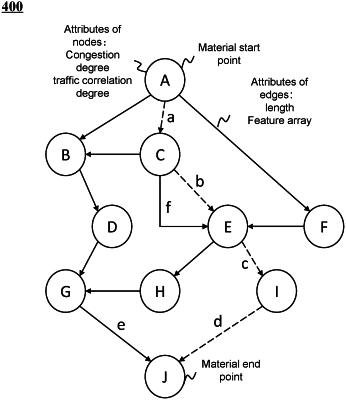| CPC G05B 19/41895 (2013.01) [G05B 19/4185 (2013.01); G05B 2219/31005 (2013.01)] | 19 Claims |

|
1. An industrial Internet of Things for determining a target automatic guided vehicle (AGV) path, comprising a user platform, a service platform, a management platform, and a sensor network platform which are connected in sequence, wherein the management platform comprises:
an obtaining module configured to obtain an AGV route layout of a target workshop through the sensor network platform, and generate a basic layout directed graph according to the AGV route layout; and
a determination module configured to:
determine, based on the basic layout directed graph, an optimal AGV path through a second iteration approach; the second iteration approach including at least one round of second iteration, one round of the at least one round of second iteration including at least one decision-making entity, and one round of the at least one round of second iteration including:
for any decision-making entity,
determining, based on a transportation obstacle situation when moving from a kth node to second connected nodes, a connected node transition probability from the kth node to each of the second connected nodes, where k denotes an integer greater than or equal to 1, a first node corresponds to a material start point, the kth node corresponds to at least one of the second connected nodes, the second connected nodes refers to next nodes connected to the kth node in a direction indicated by the kth node, the kth node refers to any node other than a material end point in a basic layout directed graph, the each of the second connected nodes corresponds to the connected node transition probability, and the each of the second connected nodes does not include a node that the decision-making entity has passed;
determining a second connected node with a largest connected node transition probability as a (k+1)th node, the kth node to the (k+1)th node being connected by at least one first edge;
determining, based on the transportation obstacle situation of the at least one first edge, a first edge transition probability of each of the at least one first edge;
taking a first edge with a largest first edge transition probability as a first transition route of the kth node to the (k+1)th node until the (k+1)th node corresponds to a material end point, the decision-making entity returning to the material start point along a second transition route from the material start point to the material end point, the second transition route being composed of the first transition route;
updating pheromone of all the nodes and pheromone of all the edges, the pheromone being mark information left by the decision-making entity when passing the second transition route, the pheromone of the nodes being used to determine the connected node transition probability, and the pheromone of the edges being used to determine the first edge transition probability; and
after the second iteration, determining the optimal AGV path based on final pheromone of all the nodes and final pheromone of all the edges;
generate the target AGV path at least based on the optimal AGV path; and
control an AGV to carry out material transportation according to the target AGV path, and send the target AGV path to the user platform for display to a user through the service platform.
|